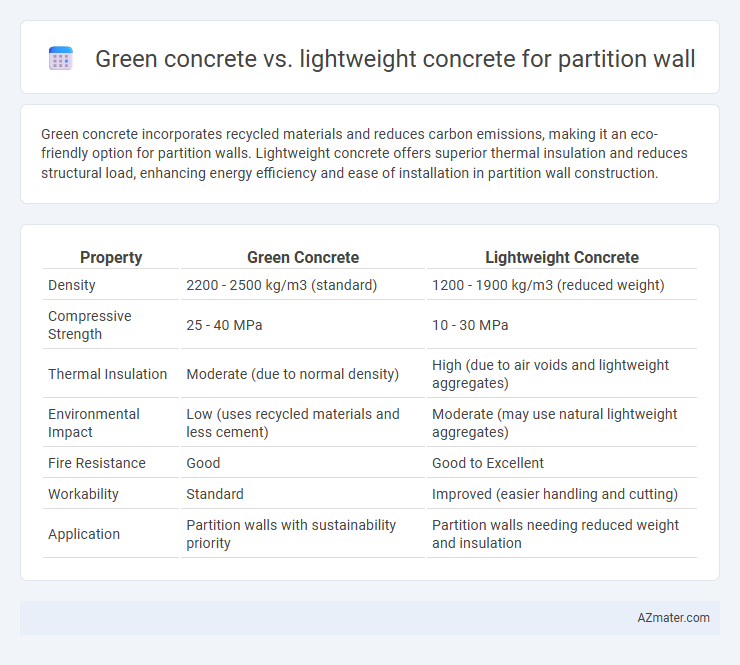Green concrete incorporates recycled materials and reduces carbon emissions, making it an eco-friendly option for partition walls. Lightweight concrete offers superior thermal insulation and reduces structural load, enhancing energy efficiency and ease of installation in partition wall construction.
Table of Comparison
| Property | Green Concrete | Lightweight Concrete |
|---|---|---|
| Density | 2200 - 2500 kg/m3 (standard) | 1200 - 1900 kg/m3 (reduced weight) |
| Compressive Strength | 25 - 40 MPa | 10 - 30 MPa |
| Thermal Insulation | Moderate (due to normal density) | High (due to air voids and lightweight aggregates) |
| Environmental Impact | Low (uses recycled materials and less cement) | Moderate (may use natural lightweight aggregates) |
| Fire Resistance | Good | Good to Excellent |
| Workability | Standard | Improved (easier handling and cutting) |
| Application | Partition walls with sustainability priority | Partition walls needing reduced weight and insulation |
Introduction to Green Concrete and Lightweight Concrete
Green concrete utilizes industrial by-products like fly ash, slag, and recycled aggregates to reduce carbon emissions and enhance sustainability in construction. Lightweight concrete incorporates lightweight aggregates such as expanded clay or vermiculite, offering reduced density and improved thermal insulation properties. Both materials serve distinct applications in partition walls, balancing environmental impact and structural performance.
Key Characteristics of Green Concrete
Green concrete for partition walls offers enhanced sustainability through the use of recycled materials and industrial by-products, significantly reducing carbon footprint compared to traditional mixes. It exhibits high durability and adequate compressive strength, often featuring lower thermal conductivity which improves energy efficiency in building interiors. Lightweight concrete, while easier to handle and providing excellent insulation due to its low density, typically sacrifices some structural strength and ecological benefits inherent in green concrete materials.
Essential Features of Lightweight Concrete
Lightweight concrete is characterized by its reduced density, typically ranging from 800 to 1,600 kg/m3, which significantly lowers the overall load on structure foundations compared to green concrete. Its thermal insulation properties are superior, with a thermal conductivity often less than 0.3 W/m*K, enhancing energy efficiency in partition walls. The material also offers excellent fire resistance and sound insulation, making it ideal for residential and commercial partitioning where weight reduction and environmental benefits are critical.
Environmental Benefits: Green vs Lightweight Concrete
Green concrete significantly reduces environmental impact by utilizing recycled materials and industrial by-products like fly ash and slag, lowering carbon emissions compared to traditional concrete. Lightweight concrete offers improved energy efficiency due to its insulating properties, reducing building energy consumption over time. Both materials contribute to sustainable construction, but green concrete excels in reducing carbon footprint during production, whereas lightweight concrete enhances operational energy savings.
Structural Performance Comparison
Green concrete, formulated with recycled materials and industrial by-products, offers enhanced environmental benefits while maintaining comparable compressive strength to traditional lightweight concrete used in partition walls. Lightweight concrete provides superior thermal insulation and reduced load on the structural framework due to its lower density, but may exhibit lower durability and higher porosity than green concrete variants. Structural performance evaluation shows green concrete partitions achieve higher strength-to-weight ratios and better long-term stability, making them advantageous for sustainable construction with moderate load-bearing requirements.
Thermal and Acoustic Insulation Properties
Green concrete offers superior thermal insulation due to its use of recycled materials and lower thermal conductivity, making it ideal for energy-efficient partition walls. Lightweight concrete excels in acoustic insulation, providing effective sound absorption and noise reduction in interior spaces thanks to its porous structure. Both materials enhance environmental sustainability, but green concrete prioritizes thermal comfort while lightweight concrete emphasizes acoustic performance in partition wall applications.
Cost Effectiveness and Affordability
Green concrete incorporates recycled materials and industrial by-products, reducing raw material costs and energy consumption, making it a cost-effective option for partition walls. Lightweight concrete offers lower transportation and handling expenses due to its reduced density, contributing to overall affordability in construction projects. Evaluating local material availability and specific project requirements is essential to determine the most economical choice between green and lightweight concrete for partition walls.
Ease of Installation and Construction
Green concrete offers enhanced ease of installation for partition walls due to its improved workability and reduced curing time, accelerating construction processes. Lightweight concrete, with its lower density, simplifies handling and positioning, reducing labor effort and structural load on supporting elements. Both materials optimize installation efficiency, but green concrete's eco-friendly composition aligns with sustainable building standards without compromising construction speed.
Suitability for Partition Wall Applications
Green concrete offers enhanced sustainability and thermal insulation properties, making it suitable for partition walls in eco-friendly construction projects. Lightweight concrete provides excellent load-bearing capacity with reduced weight, ensuring easy installation and structural efficiency in partition wall applications. Both materials improve acoustic insulation, but selecting between them depends on project-specific environmental goals and mechanical requirements.
Final Recommendations: Choosing the Right Concrete
Green concrete offers superior sustainability benefits due to its use of recycled materials and reduced carbon footprint, making it ideal for environmentally conscious partition walls. Lightweight concrete provides excellent thermal insulation and enhances structural efficiency, which is advantageous in buildings requiring energy conservation and ease of installation. For optimal partition wall performance, select green concrete when prioritizing eco-friendliness, and opt for lightweight concrete when focusing on insulation and structural lightness.

Infographic: Green concrete vs Lightweight concrete for Partition wall
 azmater.com
azmater.com